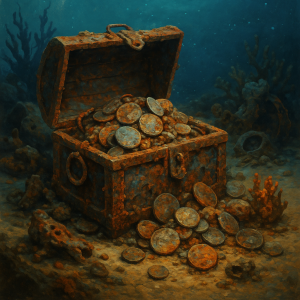Buried Myths: What Shipwreck Corrosion Really Looks Like

The phrase “shipwreck coin” carries a certain mystique. It conjures images of buried treasure, sunken galleons, and ocean-crusted riches pulled from the deep. But what does that actually mean for a coin’s condition?
This post strips away the romance and looks at the science. We’ll break down what shipwreck corrosion really is, how it affects metal over time, and why coins pulled from the ocean don’t always look like the shiny pieces you see in the movies. Whether you’re evaluating a coin marked as “shipwreck effect” or just trying to spot damage that looks suspiciously aquatic, this guide has you covered.
How Saltwater Eats Away at Metal
When a ship goes down, its coins don’t just sit there untouched, they immediately begin reacting to the surrounding environment. Saltwater is especially harsh on metal, accelerating corrosion through a mix of moisture, oxygen, and salt ions.
Over time, this causes surface damage that looks dramatically different from land-based corrosion. You’ll often see:
- Crusty buildup that can be thick, uneven, and packed with sand or marine material
- Pitting and bubbling where the metal has been eaten away
- Color changes from black to green to chalky white, depending on the metal type and the depth of the wreck
- Encrustation where the coin is partly or completely fused with surrounding debris
This kind of corrosion is less about patina and more about survival. Even when cleaned, these coins tend to show harsh surface damage that you can’t miss.
Why Everyone Thinks Their Coin Was in a Shipwreck
It’s become a go-to explanation: someone pulls out a badly corroded coin and instead of calling it what it is, they imagine a grander backstory. Maybe it sank with a pirate ship. Maybe it spent a hundred years in the ocean before being found. That would be cool… if it were true.
In reality, most coins with this level of corrosion were buried in soil, left in humid basements, or stored in PVC flips for decades. Real shipwreck coins usually come with provenance like documentation, auction history, or inclusion in a known salvage operation. Without that, it’s just a story.
If you’ve got a coin that’s crusty, dark, and pitted, it’s far more likely to be the victim of time and environment than an underwater expedition.
What Shipwreck Corrosion Really Looks Like
Authentic shipwreck coins often have a very distinct appearance. The most noticeable trait is heavy encrustation, a rough, uneven buildup of minerals fused to the surface. These aren’t just dirty coins. They’ve been chemically altered by saltwater and sediment under pressure, sometimes for centuries.
You’ll also see extreme surface loss, where the metal has been eaten away in irregular patches. Letters or devices may be partially or completely gone. The fields can look bubbled or pocked. If a silver coin still has strong detail and no rough texture, it almost certainly didn’t spend any serious time underwater.
In short: shipwreck corrosion is dramatic. And it usually doesn’t happen in your backyard.
A Common Misunderstanding
Because corrosion can be so aggressive and unpredictable, collectors sometimes assume any unusual surface must mean their coin came from a shipwreck. But here’s the reality: most corroded coins were damaged on land. Buried in acidic soil. Left in a damp basement. Forgotten in a garage for 50 years.
The romantic idea of treasure lost at sea is fun, but it’s almost never the real story. Shipwreck coins are usually documented and sold by major dealers with proper certification. If your coin didn’t come with that kind of provenance, odds are high it just suffered from everyday neglect, not maritime disaster.
